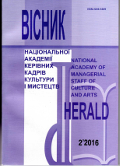HILANDAR COLLECTION AND UKRAINIAN MANUSCRIPT HERITAGE – A UNIQUE PHENOMENON OF UKRAINIAN CULTURE
DOI:
https://doi.org/10.32461/2226-3209.2.2016.138503Keywords:
Hilandar, manuscripts, Slavic (Cyrillic) and UkrainianAbstract
The purpose of the study is to identify among the Slavic manuscript heritage the Ukrainian authentic samples on the example of the manuscript collection of the Hilandar monastery on the Mount Athos. The work corresponds to the methodology of cultural and historical studies, as well as religious studies based on the study of semiotics of culture. The following research methods are used: the historic – for study of the monastery and its collection and the comparative – for identification of manuscript samples. The system of semiotics methods, which is the basis for the identification of manuscript samples belonging to a particular cultural tradition is introduced into scientific circulation. The scientific novelty of this work consists in identification of new, forgotten and unknown manuscript heritage monuments of Ukrainian culture and introduction them to the scientific circulation. Conclusion. The study confirmes that among the Slavic manuscript collections, including monastery Hilandar collection, there are the samples related to the Ukrainian cultural traditions. They are often hidden behind other names and require careful scientific study, and possibly, return to Ukraine.
Downloads
Published
Issue
Section
License
Authors who publish with this journal agree to the following terms:
1. Authors retain copyright and grant the journal right of first publication with the work simultaneously licensed under a Creative Commons Attribution License that allows others to share the work with an acknowledgement of the work's authorship and initial publication in this journal.
2. Authors are able to enter into separate, additional contractual arrangements for the non-exclusive distribution of the journal's published version of the work (e.g., post it to an institutional repository or publish it in a book), with an acknowledgement of its initial publication in this journal.
3. Authors are permitted and encouraged to post their work online (e.g., in institutional repositories or on their website) prior to and during the submission process, as it can lead to productive exchanges, as well as earlier and greater citation of published work (See The Effect of Open Access).


